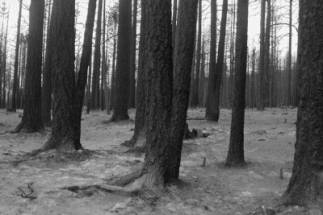|
After the fire—salvage and recovery

It is not always a total loss when a farm
forest is burnt. If the trees are of a commercial size it
might be feasible to do a salvage harvest of timber before
there is any degradation in timber quality. With most species
the harvesting must be done as soon as possible after the
fire. Dead pine trees are at risk of being infected by blue
stain fungus (that affects the appearance of the timber) and
wood-destroying insects that attack the sapwood of dead hardwoods
as the tree dies.
Even those trees that are not killed by fire might need to
be harvested immediately if part of the cambium is damaged
or exposed. The dying cambium can provide an entry point for
decay-causing fungi and wood destroying insects. Trees that
do survive the fire may also develop resin pockets (softwoods)
or gum veins (hardwoods) in their new wood. Where resin pockets
and gum veins are likely to reduce wood quality it may be
best to harvest rather than allow them to develop.
Where the foliage is burnt or scorched there is a risk that
epicormic shoots will sprout up the stem. These shoots arise
from dormant buds held in the cambium that will only grow
if the flow of carbohydrates and hormones from the canopy
is reduced. If the trees are to be retained, any epicormic
shoots may need to be removed within one growing season to
prevent a reduction in value of the sawlog.
Many Australian native species are well adapted to fire and
are able to recover or regenerate. Before clearing and replanting
a fire-damaged forest, it is worth carefully considering whether
there are alternatives that may allow a good quality forest
to regenerate. For example, seed safely stored in the soil
or in fruits can be used to start a new forest. Some species
may be able to be coppiced by cutting them back and allowing
the new shoots from the stump to grow into a new forest.
Back to top
 |
|
|
|
